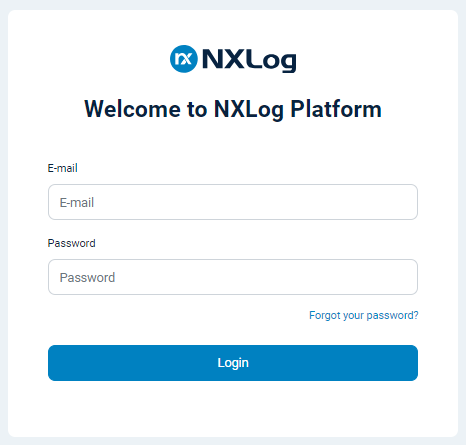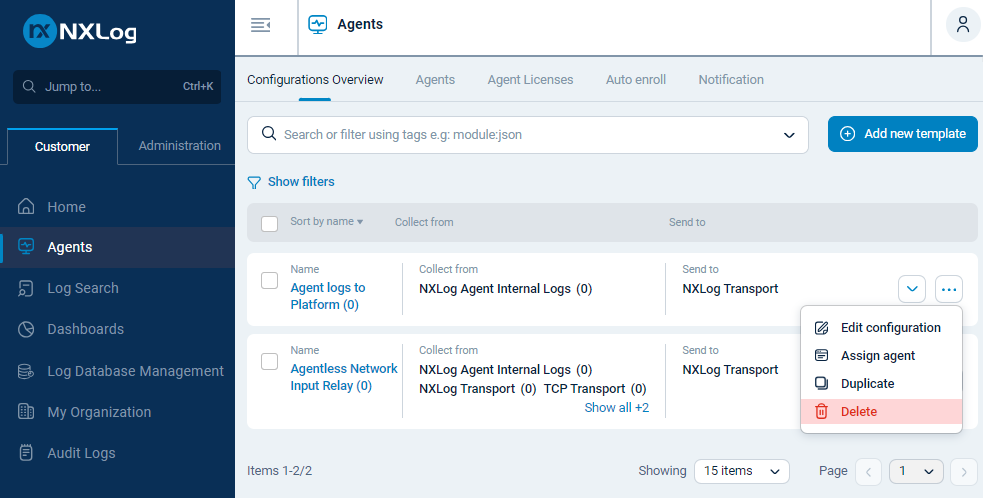Install NXLog Platform using Helm
This method deploys NXLog Platform on-premises into your Kubernetes cluster and is intended for users who already have hands-on experience with Kubernetes administration, including managing namespaces, persistent storage, and ingress configurations. The steps below guide you through installing your instance using Helm package manager for Kubernetes.
Install NXLog Platform
To install NXLog Platform with Helm, follow the steps provided in the README file located in NXLog’s official Helm chart Git repository. The README contains the most up-to-date setup instructions and usage examples.
Post-installation steps
Once you have installed NXLog Platform, we advise performing the following additional configuration steps immediately to tighten security and initiate important features.
Configure DNS
You need to configure the appropriate DNS records before you can access your NXLog Platform instance. You will likely need to do this on your corporate DNS server.
Create DNS A records for the following domain names and point them all to the IP address of the deployment machine, replacing nxlog.example.com with the actual domain you configured on /etc/nxp.conf while installing NXLog Platform.
-
platform.nxlog.example.com -
agents.nxlog.example.com -
relay.nxlog.example.com
For testing purposes, you can add the following entries to the hosts file on your workstation and on any machine running NXLog Agent.
Replace 192.168.1.123 with the IP address of your NXLog Platform host machine and nxlog.example.com with the domain you configured on /etc/nxp.conf while installing NXLog Platform:
# Your workstation must resolve the names for the services
# hosting the NXLog Platform UI
192.168.1.123 platform.nxlog.example.com agents.nxlog.example.com
# The machines running agents must resolve the names for the services
# responsible for the NXLog Platform log collection and management
192.168.1.123 relay.nxlog.example.com agents.nxlog.example.comSet up custom TLS certificates
By default, NXLog Platform uses self-signed certificates to serve the web UI and signing agent certificates. We recommend using your own TLS certificates generated by a local or public Certificate Authority (CA) for production environments.
Certificates are typically configured on the Ingress controller or LoadBalancer service.
Your cluster administrator is responsible for managing how users and agents communicate with NXLog Platform.
If you skip this step, the browser will alert you that your connection is not secure when accessing the NXLog Platform web UI.
Log in for the first time
Before you can log in to NXLog Platform, you need to configure DNS.
After the DNS records are in place, open a web browser and navigate to your NXLog Platform URL:
https://platform.nxlog.example.com
Replace nxlog.example.com with your NXLog Platform domain.
Log in to NXLog Platform using the default administrator user created during the installation:
Username: admin@localhost.local
Password: NXLogPlatform_1

Configure a mail server
NXLog Platform needs to connect to an SMTP server to send emails such as user invites, password reset requests, and system alerts. Without configuring an SMTP server, those features will be unavailable.
Refer to Configure a mail server for step-by-step instructions.
Harden the Administrator account
As the default admin account’s credentials are publicly available, we highly recommend changing them immediately after you log in for the first time.
We also recommend enabling two-factor authentication (2FA) for the account.
-
Ensure that you have configured a mail server.
-
Follow the steps to Update personal information to change the
adminemail address. We recommend changing the email address to one that you monitor regularly, as NXLog Platform sends important email notifications to the Administrator.After completing the change, use the new email address for future logins.
-
Follow the steps to Change your password for the
adminaccount. -
Follow the steps in Enable two-factor authentication to enable 2FA for the
adminaccount.
Update the NXLog Agent listening port (optional)
If you specified a different agent management port than the default 5515 when setting up the ingress profile, you must follow these additional steps:
-
Open
https://agents.nxlog.example.com/settings/agent-manager, replacingnxlog.example.comwith your domain. -
Update the port of the default enrollment address and click Save.
This ensures that NXLog Platform sends the correct port when enrolling new agents.
-
Navigate to Agents > Configurations, and delete all built-in configurations by clicking the Actions menu and choosing Delete.
NXLog Platform automatically recreates the built-in configurations using the updated NXLog Agent listening port.

